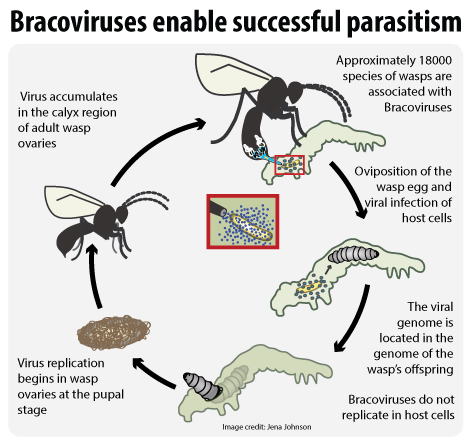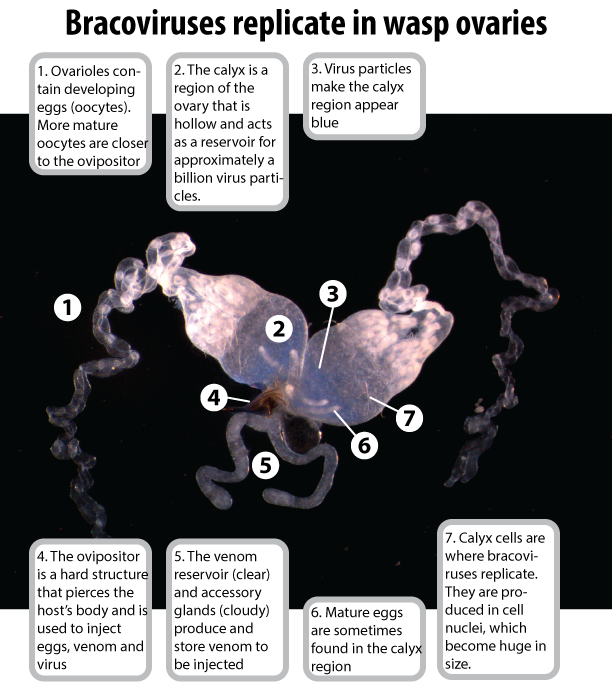Domesticated Endogenous Viruses (DEVs).
Parasitoid wasps are insects that lay their eggs in or on other insects, where their progeny feed upon and develop within their hosts, ultimately resulting in their death. Immature parasitoid wasps thus have a lifestyle in which they kill other insects or are themselves killed by hosts that can defend themselves. These highly antagonistic interactions have created opportunities for the evolution of various strategies in which parasitoids seek to overcome host defenses. DEVs are remarkable viruses that are beneficial to parasitoid wasps and at the same time are potent pathogens of the hosts of parasitoids. These viruses arise from integration of the genomes of viral pathogens into wasp genomes where they are inherited over time. Viruses are produced in wasp reproductive tissues and are injected into hosts, where they manipulate host physiology to benefit developing wasp progeny. Little is currently known about how virus- and wasp-derived genes interact to regulate viral replication and produce virus with dual roles in wasps and host insects. Our work has focused upon the discovery of new DEVs in parasitoid wasps, on the genomic architecture and evolution of viral genes present in wasp genomes, and on the functional roles of virus and wasp genes in producing virus in specialized wasp cells. We have done this in a comparative framework by comparing independently-derived DEVs in different wasp lineages.

Selected publications:
Lorenzi A, Legeai F, Jouan V, Girard P-A, Strand MR, Ravallec M, Eychenne M, Bretaudeau A, Robin S, Rochefort J, Villegas M,Burke GR, Rebollo R, Nègre N, Volkoff A-N (2024) Identification of a viral gene essential for the genome replication of a domesticated endogenous virus in ichneumonid parasitoid wasps. PLoS Pathogens. In press.
Lorenzi A, GArvin MJ, Burke GR, Strand MR (2023) Functional characterization of Microplitis demolitor bracovirus genes that encode nucleocapsid components. Journal of Virology. 97(11):e0081723.
Mao M, Simmonds TJ, Stouthamer CM, Kehoe TM, Geib SM, Burke GR (2023) A chromosome scale assembly of the parasitoid wasp Venturia canescens provides insight into the process of virus domestication. G3. jkad137
Mao M, Strand MR, Burke GR (2022) The complete genome of Chelonus insularis reveals dynamic arrangement of genome components in parasitoid wasps that produce bracoviruses. Journal of Virology. 96(5):e01573-21.
Drezen J-M, Bézier A, Burke GR, Strand MR(2022) Bracoviruses, ichnoviruses, and virus-like particles from parasitoid wasps retain many features of their virus ancestors. Current Opinion in Insect Science. 49: 93-100.
Lorenzi A, Strand MR, Burke GR, Volkoff A-N(2022) Identifying bracovirus and ichnovirus genes involved in virion morphogenesis. Current Opinion in Insect Science. 49: 63-70.
Burke GR, Hines HM, Sharanowski BJ (2021) The presence of ancient core genes reveals endogenization from diverse viral ancestors in parasitoid wasps. Genome Biology and Evolution. 13(7): evab105.
Arvin MJ, Lorenzi A, Burke GR, Strand MR (2021) MdBVe46 is an envelope protein that is required for virion formation by Microplitis demolitor bracovirus. Journal of General Virology. 102(3): 001565.
Sharanowski BJ, Ridenbaugh RD, Piekarski PK, Broad GR, Burke GR, Deans AR, Lemmon AR, Moriarty Lemmon EC, Diehl GJ, Whitfield JB, Hines HM (2021) Phylogenomics of Ichneumonoidea (Hymenoptera) and implications for evolution of mode of parasitism and viral endogenization. Molecular Phylogenetics and Evolution. 156:107023.

Symbiotic parasitoid viruses.
While some parasitoids have acquired DEVs for use in host-parasitoid interactions, other parasitoid wasps have gained true symbiotic associations with viruses. These viruses maintain an autonomously replicating genome and are not integrated into wasp genomes. One key deficiency in our understanding of the evolution of viral symbiosis is the lack of examples characterized at a functional and molecular level. DEVs produced by parasitoids are the only beneficial viruses for which extensive functional, evolutionary, and genomic data exist. In contrast, very little is known about typical viral symbionts, which are abundant among parasitoid species. The objective of this project is to explore the processes that have occurred during viral transition to a beneficial role. Dr. Burke’s lab is studying a recently acquired exogenous viral symbiont in the wasp species Diachasmimorpha longicaudata. D. longicaudata is a larval-to-pupal parasitoid of a wide range of economically important tephritid fly hosts. The venom glands of D. longicaudata wasps contain an entomopoxvirus with a double stranded DNA genome known as D. longicaudata entomopoxvirus (DlEPV). The advantage of studying a recently evolved symbiont is that signatures of transitory phases should still be evident in the viral (and possibly wasp) genomes. Dr. Burke’s group is actively studying its transmission and replication cycle, effects upon the fly immune system that could promote parasitism success, and activity in wasps and fly hosts. Identification of features in the transition from a pathogenic to beneficial role is important for understanding the evolution of biological complexity in the form of animal-microbial symbioses.

Selected publications:
Coffman KA, Kauwe AN, Gillette NE, Burke GR, Geib SM(2024) Host range of a parasitoid wasp is linked to host susceptibility to its mutualistic viral symbiont. Molecular Ecology. 33(17):e17485.
Coffman KA, Hankinson QM, Burke GR (2022) A viral mutualist employs post-hatch transmission for vertical and horizontal spread among parasitoid wasps. Proceedings of the National Academy of Sciences. 119 (16) e2120048119.
Coffman KA, Burke GR (2020) Genomic analysis reveals an exogenous viral symbiont with dual functionality in parasitoid wasps and their hosts. PLoS Pathogens. 16(11):e1009069.
Coffman KA, Harrell TC, Burke GR (2020) A mutualistic poxvirus exhibits convergent evolution with other heritable viruses in parasitoid wasps. Journal of Virology. 94:e02059-19.
